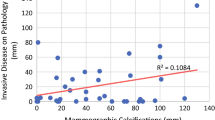Abstract
Background
This study aimed to determine the relationship between mammographic calcifications and magnetic resonance imaging (MRI) tumoral enhancement before and after neoadjuvant chemotherapy (NAC) and to assess the impact of these findings on surgical management.
Methods
This Institutional Review Board-approved, Health Insurance Portability and Accountability Act (HIPAA)-compliant retrospective study involved breast cancer patients who underwent NAC between 2009 and 2015. The study cohort comprised 90 patients with pre- and posttreatment MRI and mammograms demonstrating calcifications within the tumor bed either at presentation or after treatment. The data gathered included pre- and post-NAC imaging findings and post-NAC histopathology, particularly findings associated with calcifications. Comparisons were made using Fisher’s exact test, with p values lower than 0.05 considered significant.
Results
Complete resolution of MRI enhancement occurred for 44% of the patients, and a pathologic complete response (pCR) was achieved for 32% of the patients. No statistically significant correlation between changes in mammographic calcifications and MRI enhancement was found (p = 0.12). Resolution of enhancement was strongly correlated with pCR (p < 0.0001). The majority of the patients with pCR demonstrated complete resolution of enhancement (79%, 23/29). No statistically significant relationship was found between changes in calcifications and rates of pCR (p = 0.06). A pCR was achieved most frequently for patients with resolution of enhancement and new, increasing, or unchanged calcifications (p < 0.0001).
Conclusions
Although calcifications seen on post-NAC mammography may be associated with benign disease, loss of MRI enhancement does not predict the absence of residual tumor with sufficient accuracy to leave calcifications in place. Complete excision of tumor bed calcifications remains standard practice and a substantial limitation to NAC use for downstaging patients to be eligible for breast conservation treatment.

Similar content being viewed by others
References
Kaufmann M, Hortobagyi GN, Goldhirsch A, et al. Recommendations from an international expert panel on the use of neoadjuvant (primary) systemic treatment of operable breast cancer: an update. J Clin Oncol. 2006;24:1940–9.
Teshome M, Hunt KK. Neoadjuvant therapy in the treatment of breast cancer. Surg Oncol Clin North Am. 2014;23:505–23.
Redden MH, Fuhrman GM. Neoadjuvant chemotherapy in the treatment of breast cancer. Surg Clin North Am. 2013;93:493–9.
Holmes D, Colfry A, Czerniecki B, et al. Performance and practice guideline for the use of neoadjuvant systemic therapy in the management of breast cancer. Ann Surg Oncol. 2015;22:3184–90.
Mamtani A, Barrio AV, King TA, et al. How often does neoadjuvant chemotherapy avoid axillary dissection in patients with histologically confirmed nodal metastases? Results of a prospective study. Ann Surg Oncol. 2016;23:3467–74.
Rosen EL, Blackwell KL, Baker JA, et al. Accuracy of MRI in the detection of residual breast cancer after neoadjuvant chemotherapy. AJR Am J Roentgenol. 2003;181:1275–82.
Yeh E, Slanetz P, Kopans DB, et al. Prospective comparison of mammography, sonography, and MRI in patients undergoing neoadjuvant chemotherapy for palpable breast cancer. AJR Am J Roentgenol. 2005;184:868–77.
Jochelson MS, Lampen-Sachar K, Gibbons G, et al. Do MRI and mammography reliably identify candidates for breast conservation after neoadjuvant chemotherapy? Ann Surg Oncol. 2015;22:1490–5.
De Los Santos JF, Cantor A, Amos KD, et al. Magnetic resonance imaging as a predictor of pathologic response in patients treated with neoadjuvant systemic treatment for operable breast cancer. Translational Breast Cancer Research Consortium Trial 017. Cancer. 2013;119:1776–83.
Adrada BE, Huo L, Lane DL, Arribas EM, Resetkova E, Yang W. Histopathologic correlation of residual mammographic microcalcifications after neoadjuvant chemotherapy for locally advanced breast cancer. Ann Surg Oncol. 2015;22:1111–7.
Weiss A, Lee KC, Romero Y, et al. Calcifications on mammogram do not correlate with tumor size after neoadjuvant chemotherapy. Ann Surg Oncol. 2014;21:3310–16.
Kim YS, Chang JM, Moon HG, Lee J, Shin SU, Moon WK. Residual mammographic microcalcifications and enhancing lesions on MRI after neoadjuvant systemic chemotherapy for locally advanced breast cancer: correlation with histopathologic residual tumor size. Ann Surg Oncol. 2016;23:1135–42.
National Comprehensive Cancer Network. Breast Cancer Version 2.2016. Retrieved 30 August 2016 at https://www.nccn.org/professionals/physician_gls/pdf/breast.pdf.
American College of Radiology (ACR). ACR Breast Imaging Reporting and Data System (BI-RADS). 4th ed. Reston, VA: American College of Radiology; 2003
Moskovic EC, Mansi JL, King DM, Murch CR, Smith IE. Mammography in the assessment of response to medical treatment of large primary breast cancer. Clin Radiol. 1993;47:339–44.
Acknowledgment
This study was funded in part through NIH/NCI Cancer Center Support Grant P30 CA008748.
Author information
Authors and Affiliations
Corresponding author
Ethics declarations
Disclosure
There are no conflicts of interest.
Rights and permissions
About this article
Cite this article
Feliciano, Y., Mamtani, A., Morrow, M. et al. Do Calcifications Seen on Mammography After Neoadjuvant Chemotherapy for Breast Cancer Always Need to Be Excised?. Ann Surg Oncol 24, 1492–1498 (2017). https://doi.org/10.1245/s10434-016-5741-y
Received:
Published:
Issue Date:
DOI: https://doi.org/10.1245/s10434-016-5741-y




